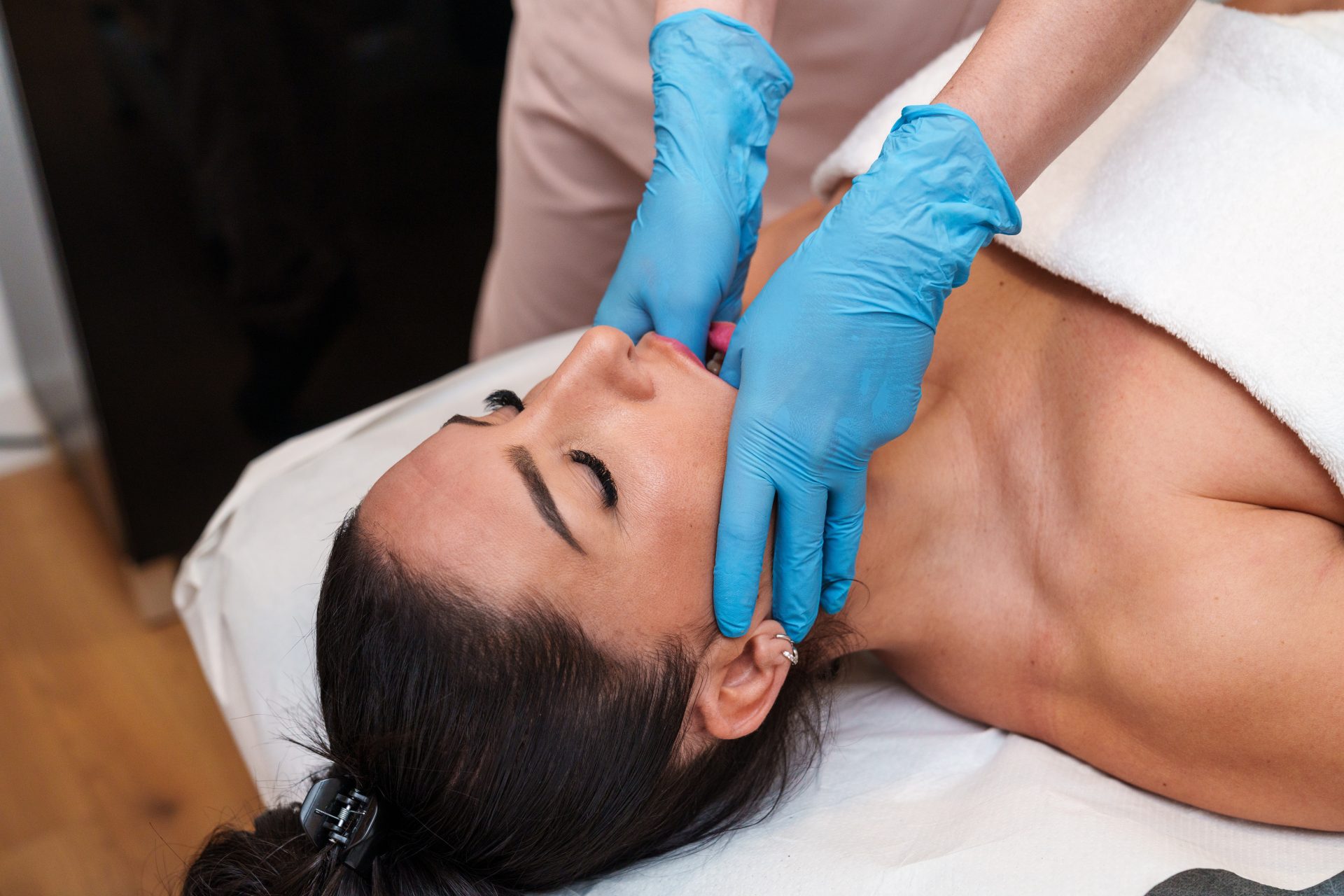The tiny needle that has transformed millions of faces worldwide is now offering hope to people suffering from a completely different kind of pain. While Botox has long been celebrated for its ability to erase wrinkles and create smoother skin, medical professionals are discovering its remarkable potential to provide life-changing relief for individuals battling temporomandibular joint disorder, commonly known as TMJ.
This groundbreaking application of botulinum toxin represents a significant shift in how medical professionals approach chronic jaw pain, teeth grinding, and the debilitating symptoms that can make simple activities like eating, talking, or sleeping feel nearly impossible. For thousands of Americans who have exhausted traditional treatment options, Botox is emerging as an unexpected solution that addresses the root cause of their suffering.
The journey from cosmetic enhancement to medical treatment showcases the evolving understanding of how Botox works within the human body. What began as an observation about muscle relaxation for aesthetic purposes has expanded into a comprehensive approach to managing chronic muscle tension and pain disorders that affect millions of people daily.
Understanding the hidden epidemic of TMJ disorders
Temporomandibular joint disorder encompasses a complex group of conditions that create dysfunction and excruciating pain in the jaw joint and surrounding muscles responsible for controlling jaw movement. This intricate system, which most people take for granted, becomes a source of constant agony for those affected by TMJ disorders.
The symptoms extend far beyond simple jaw discomfort, creating a cascade of issues that can dramatically impact quality of life. Sufferers frequently experience persistent jaw stiffness that makes opening the mouth difficult, chronic pain that radiates throughout the face and neck, recurring headaches that can be mistaken for migraines, and involuntary teeth grinding that occurs primarily during sleep but can persist throughout the day.
The grinding and clenching associated with TMJ disorders often create additional dental problems, including worn tooth surfaces, cracked teeth, and increased sensitivity. Many individuals find themselves avoiding certain foods, speaking less frequently, or struggling with sleep disruption due to nighttime clenching episodes that leave them exhausted and in pain upon waking.
Traditional medical approaches have typically focused on managing symptoms rather than addressing the underlying muscle tension that drives many TMJ disorders. This limitation has left countless individuals searching for more effective solutions that can provide meaningful, lasting relief from their chronic pain and dysfunction.
The science behind Botox muscle relaxation therapy
The mechanism by which Botox provides relief for TMJ disorders represents a fascinating intersection of neuroscience and practical medical application. Botulinum toxin works by temporarily blocking the release of acetylcholine, a crucial neurotransmitter responsible for signaling muscles to contract and maintain tension.
When acetylcholine cannot effectively communicate with muscle fibers, the targeted muscles enter a state of controlled relaxation that reduces their ability to maintain the chronic tension patterns characteristic of TMJ disorders. This relaxation effect allows the jaw joints to move more freely while simultaneously reducing the constant muscle strain that contributes to pain and dysfunction.
The targeted approach of Botox treatment means that only specific muscles receive the neurotoxin, leaving surrounding muscles and normal jaw function largely unaffected. This precision allows individuals to maintain essential jaw movements for eating, speaking, and other daily activities while experiencing significant reduction in the problematic muscle patterns that cause their symptoms.
Patients frequently report improvements that extend beyond simple pain reduction. Enhanced jaw mobility facilitates more comfortable chewing, talking, and yawning, while improved sleep quality results from decreased nighttime clenching and grinding. The reduction in jaw clicking and popping sounds, which can be both physically uncomfortable and socially embarrassing, represents another significant benefit that improves overall quality of life.
The 7 life-changing benefits transforming patient experiences
The therapeutic effects of Botox for TMJ disorders create a comprehensive improvement in multiple aspects of daily functioning that extends far beyond the immediate area of treatment. These benefits work synergistically to create meaningful changes in how individuals experience their daily lives.
Enhanced jaw movement represents the first and most immediate benefit that patients typically notice. The ability to open the mouth fully without pain or restriction allows for more comfortable eating, clearer speech, and the simple pleasure of yawning without discomfort. This improved mobility often surprises patients who have gradually adapted to limited jaw function over months or years of progressive symptoms.
Improved sleep quality emerges as the second major benefit, often developing within the first few weeks of treatment. The reduction in nighttime clenching and grinding allows for more restful sleep patterns, leading to improved energy levels, better mood regulation, and enhanced cognitive function during waking hours.
The third benefit involves significant reduction in teeth grinding and clenching behaviors, particularly during sleep when these activities typically occur without conscious awareness. This reduction helps protect dental work, prevents further tooth damage, and eliminates the jaw fatigue that many individuals experience upon waking.
Decreased jaw clicking and popping sounds represent the fourth benefit, addressing both the physical discomfort and social embarrassment that these audible symptoms can create. Many patients report feeling more confident in social situations when they no longer worry about others hearing their jaw dysfunction.
The fifth benefit encompasses broad pain reduction that extends throughout the jaw, face, neck, and shoulder regions. This comprehensive pain relief often surprises patients who may not have realized how extensively their TMJ symptoms were affecting surrounding muscle groups and contributing to tension patterns throughout their upper body.
Lower overall muscle tension constitutes the sixth benefit, which may provide relief from headaches and migraines that were previously attributed to other causes. Many individuals discover that their chronic headache patterns improve significantly once jaw muscle tension is addressed through Botox treatment.
The seventh benefit involves improved emotional well-being and quality of life that results from the cumulative effect of all other improvements. Chronic pain conditions often contribute to anxiety, depression, and social withdrawal, so addressing the underlying physical symptoms can have profound psychological benefits.
The precise procedure that delivers results
The administration of Botox for TMJ treatment represents a carefully orchestrated medical procedure that requires specialized knowledge of facial anatomy and injection techniques. The entire process typically requires between 10 to 30 minutes in a clinical setting, making it accessible for individuals with busy schedules who cannot commit to lengthy treatment sessions.
Qualified healthcare providers who perform these injections include dentists with specialized training, oral and maxillofacial surgeons, pain management specialists, and other medical professionals who have received appropriate certification in Botox administration techniques. The selection of an experienced provider is crucial for achieving optimal results while minimizing potential complications.
During the procedure, providers use extremely fine needles to deliver precise amounts of Botox into specific jaw muscles that contribute to TMJ symptoms. The masseter muscle, located along the jawline, represents the primary target for most patients due to its central role in chewing and clenching behaviors that characterize many TMJ disorders.
The pterygoid muscles, situated deeper within the jaw structure, aid in opening and lateral jaw movements and may require treatment in cases where patients experience difficulty with these specific motions. The temporalis muscles, found on the sides of the head above the ears, assist in chewing and jaw elevation and are often included in comprehensive treatment protocols.
Most patients describe the injection sensation as a brief, mild pinch that is easily tolerable without any form of anesthesia or numbing agents. The lack of required anesthesia allows individuals to return to their normal daily activities immediately following the procedure, though certain precautions are recommended to optimize treatment outcomes.
Post-treatment guidelines typically include avoiding strenuous physical activities for several hours and refraining from massaging or applying pressure to the injection sites. These precautions help ensure that the Botox remains in the intended treatment areas and achieves maximum therapeutic benefit.
Identifying ideal candidates for Botox TMJ therapy
The determination of whether an individual represents a good candidate for Botox treatment involves careful evaluation of their medical history, current symptoms, and previous treatment experiences. Healthcare providers typically recommend Botox for patients whose TMJ symptoms have persisted despite attempts at conventional treatment approaches.
Traditional treatments that are usually attempted before considering Botox include custom-fitted mouthguards or splints designed to prevent nighttime grinding and clenching. These devices work for some individuals but may be ineffective for those with severe muscle tension or complex jaw movement patterns.
Medications commonly prescribed for TMJ disorders include anti-inflammatory drugs, muscle relaxants, and pain medications. While these can provide temporary symptom management, they often fail to address the underlying muscle dysfunction and may carry side effects that limit their long-term usefulness.
Physical therapy approaches focus on jaw exercises, stretching techniques, and manual therapy designed to improve jaw mobility and reduce muscle tension. Some patients experience significant improvement through these methods, while others find limited benefit from conservative physical interventions.
Trigger point therapy involves targeted pressure applied to specific muscle knots or tension points that may be contributing to TMJ symptoms. This approach can be effective for some individuals but may not provide sufficient relief for those with widespread muscle involvement or chronic tension patterns.
Individuals who should not receive Botox treatment include pregnant or breastfeeding women, as the effects of botulinum toxin on developing fetuses or nursing infants have not been fully established. People with known allergies to botulinum toxin or any components of Botox formulations should also avoid this treatment option.
Certain neurological conditions, including myasthenia gravis, Lambert-Eaton syndrome, or ALS, represent contraindications to Botox treatment due to the potential for these conditions to interact negatively with neuromuscular blocking agents.
Understanding potential risks and managing expectations
Like all medical procedures, Botox treatment for TMJ carries certain risks and potential side effects that patients should understand before proceeding with treatment. The majority of side effects are mild, temporary, and resolve without intervention within a few days to weeks following injection.
Common side effects include flu-like symptoms that may develop within the first 24 to 48 hours after treatment. These symptoms typically involve mild fatigue, low-grade headache, and general malaise that resembles a minor viral illness and resolves quickly without specific treatment.
Injection site reactions represent another category of common side effects, including temporary pain, swelling, bruising, or redness at the locations where Botox was administered. These local reactions are usually minimal and can be managed with ice application and over-the-counter pain relief if necessary.
Some patients experience mild headaches following Botox injections, which may seem counterintuitive given that headache relief is often a desired outcome of treatment. These post-injection headaches are typically short-lived and may actually represent a transitional phase as muscle tension patterns begin to change.
Nausea occasionally occurs following Botox treatment, though this side effect is relatively uncommon and usually resolves within 24 hours. Patients who experience nausea should avoid driving or operating machinery until symptoms completely resolve.
Serious side effects are rare but can occur, particularly if Botox spreads beyond the intended treatment areas or if patients have underlying medical conditions that increase their susceptibility to complications. Allergic reactions, while uncommon, can range from mild skin reactions to severe systemic responses requiring immediate medical attention.
Difficulty swallowing or breathing represents the most serious potential complication and requires immediate emergency medical evaluation. These symptoms suggest that Botox may have affected muscles involved in swallowing or respiratory function, though this occurrence is extremely rare when treatment is performed by qualified providers.
Unintended muscle weakness in areas adjacent to injection sites can occasionally occur, potentially affecting facial expression or other jaw movements. These effects are typically temporary but may be concerning for patients who depend on precise facial muscle control for their profession or personal confidence.
Financial considerations and cost management strategies
The financial investment required for Botox TMJ treatment represents a significant consideration for many patients, particularly given that multiple sessions are typically necessary to maintain therapeutic benefits. Treatment costs generally range from $500 to $1,500 per session, with variation depending on geographic location, provider experience, and the amount of Botox required for effective treatment.
The temporary nature of Botox effects means that treatments must be repeated approximately every three months to maintain symptom relief. This ongoing requirement creates an annual cost estimate ranging from $2,000 to $6,000, which can represent a substantial financial commitment for individuals and families.
Insurance coverage for Botox TMJ treatment varies significantly among different insurance providers and specific policy terms. Some insurance plans may cover treatment when it is deemed medically necessary and when conservative treatments have been unsuccessful. However, many plans still classify Botox as a cosmetic treatment regardless of its medical application, leading to coverage denials.
To maximize the likelihood of insurance coverage, patients should work with their healthcare providers to document the medical necessity of treatment through comprehensive records of previous treatments attempted, ongoing symptoms, and functional limitations caused by TMJ disorders. Detailed documentation can support appeals processes when initial coverage requests are denied.
Payment plan options offered by many healthcare providers can help make treatment more accessible by spreading costs over several months rather than requiring full payment at the time of service. These arrangements often involve no interest or low-interest financing that makes treatment financially feasible for individuals who cannot pay large lump sums.
Shopping for competitive pricing among qualified providers can yield significant cost savings while maintaining treatment quality. However, patients should prioritize provider qualifications and experience over cost alone, as proper injection technique is crucial for both safety and effectiveness.
Teaching clinics and residency programs sometimes offer Botox treatments at reduced costs as part of their educational missions. These settings provide supervised treatment by trainees under the guidance of experienced professionals, potentially offering cost savings while maintaining safety standards.
Healthcare flexible spending accounts and health savings accounts can often be used to pay for medically necessary Botox treatments, providing tax advantages that effectively reduce the overall cost of care. Patients should obtain letters of medical necessity from their providers to support FSA or HSA usage for these treatments.
Long-term outlook and treatment planning
The decision to pursue Botox treatment for TMJ disorders should be viewed as part of a comprehensive, long-term approach to managing chronic jaw dysfunction rather than a quick fix or temporary solution. While many patients experience significant improvement relatively quickly, optimal results often develop gradually over multiple treatment cycles.
Treatment planning typically involves an initial series of injections followed by assessment periods to evaluate response and adjust injection sites, dosages, or timing as needed. This individualized approach recognizes that each patient’s anatomy, symptom patterns, and treatment response are unique and may require modifications to achieve optimal outcomes.
Many patients find that their treatment requirements change over time, with some needing less frequent injections as their muscle tension patterns improve and others requiring adjustments to maintain consistent symptom control. Regular follow-up appointments allow providers to monitor treatment effectiveness and make necessary modifications to treatment protocols.
The integration of Botox treatment with other therapeutic approaches often yields the best long-term results for patients with complex TMJ disorders. Continued use of protective mouthguards, stress management techniques, physical therapy exercises, and lifestyle modifications can complement Botox treatment and potentially extend the duration of symptom relief between injection sessions.
Patient education about factors that can influence treatment effectiveness, including stress levels, sleep quality, dietary choices, and jaw habits, empowers individuals to take an active role in managing their condition and maximizing their treatment investment.
The evolving field of Botox applications continues to refine techniques, dosing protocols, and injection strategies that may improve treatment outcomes while reducing costs and side effects. Patients who choose this treatment approach become part of an ongoing medical advancement that may benefit from continued improvements in technique and understanding.
For individuals whose lives have been significantly impacted by chronic TMJ symptoms, Botox treatment represents a potentially transformative option that addresses the underlying muscle dysfunction driving their pain and disability. While the financial commitment and need for ongoing treatment require careful consideration, the potential for meaningful improvement in quality of life makes this innovative approach worthy of serious consideration for appropriate candidates.












